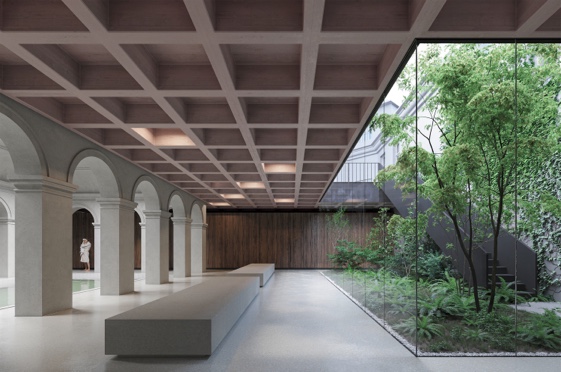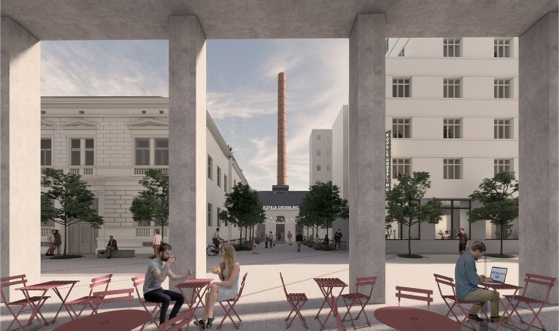We present to you the future of Grössling
The winning proposal of the architectural competition allows not only to restore the architectural significance of Grössling, but also to rediscover the ancient social and cultural value it has for the city of Bratislava. The design fulfills the vision of connecting the function of the bath, the city library and the house of literature, allowing you to create a contemporary model of a complex building that benefits from its diverse functions.
The winning proposal:
OPPS Architettura - Florence





The design restored the original entrance to the spa from 1895 on the corner of Medená and Kúpeľná streets. Relatively few entrances to the complex ensure smooth service of the entire building, therefore the functional operating concept is evaluated very positively.
The jury appreciates the use of material of the inserted structure, which creates an atmosphere that correlates with the overall character of the building. Glazed constructions refer to the development period of the original spa while creating generous spaces with a time fragile touch. Inserted structures work with different degrees of openness to the environment – they do so depending on the function of the adjoining spaces and the intention of the authors.
2nd - 5th place


Team Tvar and Roar architects
Bratislava
The highly appreciated aspect of the proposal is its clear urban division and the high-quality overall concept of the proposal. Unlike the winning design, in this case the authors are working with a more significant opening of the block's premises to the surrounding environment - they involved the space on Kúpeľná Street and defined the use of exterior terraces inside the block. A separate entrance to the spa located on Kúpeľná Street creates a generous anteroom that visually communicates with the interior of the historic boiler room and presents the spa to a passerby. Placing the locker rooms in the basement with natural light allows the establishment of a public function on the entire ground floor of the building. The jury appreciates the proposed cultivated material solution, however, the missing interior connection between the spa and the library part is perceived as questionable. The consistency of the architectural solution of the newly created interventions was assessed by the jury as rather disputable.
Detail in PDF

mar.s architects
Praha
The jury appreciates a well-designed public space as it is very pleasant with a sensible city character. The solution of the intersection of Medená and Kúpeľná streets favors pedestrians in the area. Entrance to the spa through the yard, to the locker rooms on the ground floor without crossing traffic was appreciated by the jury. The readability of the new layer is evaluated positively, however doesn’t respect the preservation of the historical value. The advantage is that it does not act as an exhibition, but as a negative was perceived the absence of a clear architectural expression associated with the object of the spa. The resting area is underestimated and its location by the entrance is not ideal to serve the function due to its busy character. The placement of the locker rooms and the entrance to saunas through the main pool is questionable. The exposed wall in the passage on Kúpeľná Street with ivy and graffiti is acts overly temporary.
Detail in PDF

Team Grau architects
Bratislava
The positive aspect of the design is the location of the library and café facing the park on Medená Street. The authors have created an operating scheme that allows the busy and quiet areas of the bath to be separated, but the swimming pool does not have its own access. From the historical preservation point of view, this conservative proposal is evaluated. It preserves the exterior expression of the building without significant interventions or additions. The design does not propose a significant atmosphere and the interior design does not provide any significant added value. The proposed design isn’t barrieless, either. The changing rooms occupy a valuable space on the 1st floor and mixes clean and dirty traffic as well as the bistro supply route. The rest area has a transit character. Four outdoor water areas are a relatively energy-exhausting solution and therefore not sustainable.
Detail in PDF

Deichler Jakab Stúdió
Budapest
The design brings a generous new entrance area on Kúpeľná street, through a proposed shelter. However, the validity of the building and the architectural expression of the proposed neoplasm raises several questions. The sauna and spa area are functional from an operational point of view and bring well-distributed relaxation areas. The authors work extensively with the roof landscape of the building. The design brings quite a lot of interventions into historic load-bearing structures. Although the proposed "passage" on the ground floor creates a potential public space, it is not convincing and complicates the operational strategy and takes up space from other areas by creating inputs and combining several functions. The division of the building in both the library area as well as in the spa part creates quite a lot of barriers, and the design does not follow up on that. In some instances, the architectural expression and the atmosphere of the design disproportionately affects the existing object and the assigned function.
Detail in PDFJury
Ilja Skoček (SK)
architect, Chairman of the Slovak Chamber of Architects, Chairman of competition
Lászlo Kovács (HU)
Operations Director of the Budapest Spa
Adam Halíř (CZ)
architect
www.projektil.cz
Henrieta Moravčíková (SK)
theoretician of architecture, Faculty of Architecture and Design STU in Bratislava
Peter Lényi (SK)
architect, www.2021.sk
Head of Competition department of the Metropolitan Institute of Bratislava
Zuzana Zacharová (SK)
architect
www.designfactory.sk
Peter Fejérdy (HU)
architect
www.kozep.bme.hu/fejerdy-peter-dla
Appreciated and valuable aspects of the rest of the proposals
77 teams from different parts of the world took part in the competition. These proposals were appreciated for their imaginativeness, inspiration or emotion which they brought to Grössling with their design.
light
play

The proposal works with various forms of resting and relaxation zones. The division of the newly created space brings a new atmosphere to the original historic spa. Through exploring a sophisticated light play, the author managed to create intimate spaces with different characters.
FORMA architects / New York
Garden yard inside

The design works very well with the garden yard inside the complex. It consists of an interconnected two-level landscape with inserted objects of human-scale saunas. This garden creates the atmosphere of a mysterious green world with a relaxed and informal character. The functional grid inside the bath establishes spaces arranged in a scenic labyrinth and thus eliminates corridors. The authors work with a vertical form of a library open across three floors, creating a generous open space for study and meetings.
GUTGUT / Bratislava
The essence of man as the essence of a bath

The authors of the proposal perceive Grössling bath as a combined space that holistically supports and develops the essence of man – the body with all its possibilities and mistakes, and the mind an intellectual stimulation to create a rich inner life. It focuses on the juxtaposition of body and mind, which is the basis of various zones of spas and libraries.
Note design studio / Stockholm
Vertical
greenery

The authors work with arcades and arches to transform them into a new design. They create an orangery with a relaxation zone where visitors can relax surrounded by vertical greenery
Karaivanov architekten / Vienna + Buka / Berlin
Roman
baths

Inspired by the Roman baths of Pompeii, the basis for the overall spatial quality and the layout of the rooms are grounded in an ancient concept.
Guetano Guerrera / Termoli
Chimney
view

On the chimney, which is located between the café and the library, these architects provided a view of the Old Town of Bratislava.
Hantabal architekti / Bratislava
Library
in the pool

We perceive the proposal as an interesting experiment. The authors turned the operation of the bath and placed a library in the existing pools. In the swimming pool is created an amphitheater for concentrated work. The new pools are located in the central part of the building.
CAN Architects / Győr
Swimming pool
in the chimney

The design explores the chimney that has already lost its original function but forms a landmark of the area to this day. The proposal places the swimming pool with hot water inside and around the chimney. Architects bring the chimney back to life to symbolise the activity of new public life.
Ludovic Gaffarel / Brussels
Intimate
atmosphere

The authors of the proposal create new massing in the concept- a sauna in the inner courtyard and a swimming pool in the courtyard on Kúpeľná Street, thus continuing the materiality of the chimney and at the same time creating a quiet, intimate atmosphere in them.
ARCHI-KON / Budapest
Visual connection of spaces

The design works with the opening of the premises and responses with additions to the block structure. The new forms bring more light and visual connection to the interior.
ARRE arhitektura / Ljubjana
Entrance hall under the arcades

The proposal creates an interesting entrance hall under the arcades and works with a visual connections across vertical divisions.
3H / Budapest
Spacial
division

The design works with a sequential division of the space, inside the floorplan it divides the space into different types of relaxation and interactive zones, the overall proportion of which is conditioned by the required amount of light and acoustics of each function.
SOVA SZENK / Wroclaw
All details about the projects can be found on the website of the Metropolitan Institute of Bratislava
All proposals on mib.sk
NEWS ABOUT THE RECONSTRUCTION
Follow the continuing reconstruction and peek into the history, the present as well as the future of Grössling on our Instagram.


Jury’s evaluation
The winning design responds best to the demand of creating a quiet, closed city block with a well-designed flexible square with a defined relationship to the surrounding city. The authors were able to follow up on the historical value of the complex and increase the quality of the building with simple interventions. The design makes full use of the existing premises and contains almost no destructive interventions and thus highlights the value and patina of the 125-year-old building and at the same time creates a functional operating scheme for the spa, the library and the cafe.
The operation design clearly defines the relationship of the swimming pool, saunas and the spa itself while separating the busy and the quiet zones of the library. The forecourt of the spa on Medena Street is designed as a quiet urban public space with outdoor seating.